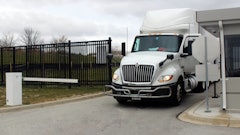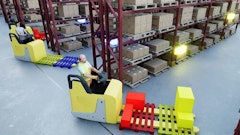"This is certainly an interesting time to be in logistics," says Pat Johnson, the manager of logistics at Land O'Lakes, the dairy company based in Arden Hills, MN. "In addition to challenges like rising fuel prices, changes in hours-of-service regulations and driver shortages, there are rail constraints and years of carrier attrition. They are really straining capacity as well as budgets."
That's how the manager of logistics reacted to the findings in the Grocery Manufacturers Association's (GMA) fifth benchmark survey on logistics. The survey of 32 consumer products manufacturing companies was conducted by IBM Business Consulting Services in conjunction with GMA.
The survey found that in the last three years transportation costs have increased 23 percent to an average of $1.69 per mile. Transportation now accounts for 62 percent of all logistics costs. The bottom line is that higher than anticipated fuel prices have contributed greatly to the increasing cost of transportation.
Here are the key points:
- Transportation is driving up production costs in the food, beverage and consumer products industry;
- Changes to HOS regulations for truck drivers have had a domino effect. By limiting the average distance a truck driver can cover in a single day, carriers found it more difficult to retain enough drivers to meet demand and overall shipping capacity dropped; and
- More retailers are relying on manufacturers to address the challenges of moving freight today.
"For GMA member companies, responding to the needs of retail customers and reducing costs are constant goals. However, achieving these goals is more challenging than ever as transportation costs continue to escalate," says Karin Croft, GMA's senior director of industry affairs.
Says Karen Butner, associate partner, IBM Institute for Business Value, Armonk, NY, "Current margin pressures are severe. In an effort to improve customer service and reduce costs, we see many consumer products companies reducing the fixed costs and capital requirements of supply chain operations and moving to a more variable cost structure that can be controlled and managed on demand."
Commenting on the survey, Lisa Hebert, a transportation consultant with Chicago-based Accenture, says, "There is a tremendous amount of pressure on shippers today, both from a pricing standpoint and also from a service standpoint. There is a combination of factors-fuel surcharges, HOS regulations and driver shortages."
In addition to the carriers' issues with retaining enough good drivers, they are also limited by the net effect of the HOS rule change, according to John Murphy, director or product marketing for G-Log, a logistics service provider in Shelton, CT.
"The HOS rule changes, in effect, highlighted inefficiencies in the supply chain process by continuing the 'meter' for carriers while they were waiting and unloading," he explains. "This limited the number of available hours that truckers could drive that day and led to shortages in the network."
He used the example of a carrier that may have been able to make a trip from Pittsburgh to Philadelphia to Cherry Hill, NJ, in one day because the driver's work time stopped at each location while he was waiting at a loading dock.
"With the HOS rule changes, the waiting time counts against the drive time and the carrier is unable to service both deliveries in a single day," says Murphy. "This causes him to decline one of the two deliveries or increase the cost of the two-delivery stop movement because the driver has an overnight requirement to make the delivery in Cherry Hill."
According to the survey, consumer product companies are addressing increased costs, reduced capacity and retailers' concerns by:
1. Shifting to different transportation modes where possible.
"We are utilizing rail where we can and where it makes sense," reports Johnson of Land O' Lakes. "But car ordering lead times and longer rail transits do not lend themselves readily to our short order cycles, refrigerated products and limited shelf lives. Rail obviously has attractive cost tradeoffs, but in our experience rail capacity currently seems to be as constrained as it is for trucks."
Welch Foods Inc., Concord, MA, has begun using boxcar and intermodal "where it makes sense," according to Bruce True, manager of logistics. "However, we've had only limited success with these modes as the rates have increased faster than trucks in many of our lanes to the point where it is more expensive than truck, and the service is suspect. Because of that, rail is mainly a choice we make only when we have no other option to get the product to the customer-that is, no truck capacity is available."
2. Using trailers better.
Welch's is striving to eliminate air weight by ensuring customers that truckload orders are filling the truck, and by making sure consolidations are as full as possible. "We have also set up a crossdocking operation in Texas that allows us to ship truckloads of small orders into the south for redistribution. This has made our freight much more carrier-friendly in that market," says True.
Customer freight is inherently less efficient than plant-to-DC freight, according to Johnson of Land O' Lakes, because it is driven by orders and not loading efficiency. "This gap in customer freight utilization is affected by many variables: Land O'Lakes' trend toward lighter products, driver HOS rule changes in 2004 that reduced customer stops/orders per load, and some of our business practices, such as small minimum order sizes or all customers having the opportunity to order once per week.
"We continuously review this utilization metric for opportunity and have already made significant progress in this area. Customer freight utilization has improved by 17 percent in the last four years by more effective transportation planning and execution and some changes to business practices-primarily by going to a standard of three days from order to ship. That allowed us to plan freight more effectively and also helps us when we are competing for trucks."
3. Taking advantage of continuous move opportunities.
"We continue to look at doing this, both within our organization and in partner with some of our customers," says Welch's True.
4. Partnering with carriers to secure year-round capacity.
Welch's has always had such a policy in place. The company pays a year-round rate for year-round service. "We do not "dial for diesel," says True. "At the same time, we have always worked to be a significant portion of business for our carriers, which results in us getting preferential treatment when trucks are tight."
Says Johnson of Land O' Lakes, "In our annual carrier meeting, we communicate our anticipated needs to our core carrier group-volumes, freight timing, new lanes and other major changes. We also do a roundtable discussion of a selected topic of mutual interest. Last year, for example, we focused on the HOS change and ways to mitigate its impact.
"We feel we have taken a balanced approach to working with our carrier partners since transitioning to a core carrier strategy several years ago," he goes on to say. "Our long-term emphasis on partnerships and focus on addressing all elements of the freight equation-cost, capacity and customer service-have helped us work with our carriers and customers to navigate through these rough waters. We have been getting trucks under our product, but like everybody else, our freight costs are up significantly this year."
Different Strokes For Different Folks
Other companies that took part in the survey are dealing with transportation challenges and addressing them in different ways. For example, The Gillette Co., Boston, has faced capacity issues relating to driver shortages primarily in the truckload category for many years. More recent events like the HOS rule changes have exacerbated the driver shortage and associated overall capacity constraints even more.
"Overall cost increases have been driven by two major factors-limited capacity and high fuel costs," explains John O'Leary, director of North American distribution. "Shippers are very limited in terms of addressing the fuel issues. It is essentially an uncontrollable expense. The capacity issue however, is addressable and has been our area of focus."
Here is how Gillette has been addressing capacity:
- Fully leveraging its transportation management system (TMS) to optimize order consolidation, load factor, mode and frequency;
- Working collaboratively with its carrier base to remove inefficiencies. "Our goal is to help and support each other to solve problems and strengthen our relationships," says O'Leary. "This extends to our bid process where the focus is no longer just price but rather a lane-by-lane matching of volume against capability;"
- Expanding the carrier base to increase backup options;
- Increasing the use of other modes, such as rail; and
- Working with customers to reduce inefficiencies within their environment.
At Land O' Lakes, the most significant initiative underway is evaluating load planning software from Nistevo Corp., Eden Pairie, MN, to assess its potential value. The dairy company is developing a pilot to look at how the load optimizer can enhance the effectiveness of its transportation planning.
Another area being investigated is collaborative freight. A team of Land O' Lakes IT executives and representatives from Nistevo have developed a systematic process that would allow them to co-ship with another food manufacturer that is sited near one of their distribution centers. The company is looking for compatible freight and appropriate co-shipping partners at this time.
Welch's is working harder to be more "carrier-friendly" by:
- Switching to appointments from first come, first serve;
- Trying to get trucks turned around faster at the docks;
- Reducing the number of stops on multi-stop loads. "In extreme cases, we have shipped a truck light rather than add an additional stop, when it is cheaper to do so," says True; and
- Adding some small warehousing and crossdocking operations in areas where there is a significant amount of "small order" business to help reduce the number of multi-stop shipments. Welch's historically has shipped almost everything directly from its plants rather than from forward warehouses.
No Relief In Sight
How does the future look to manufacturers considering the fact that fuel prices will likely remain high? "Expensive," says Johnson of Land O' Lakes. "But cost pressure is nothing new to logistics. This environment puts even more emphasis on effective supply chains-addressing internal inefficiencies, partnering with your carriers and customers to make interfaces like docks and business practices more efficient, leveraging technology and hedging fuel."
O'Leary of Gillette predicts that the driver shortage will continue to be a major problem. "The fuel crisis is difficult to project and will be further impacted by the EPA requirements on diesel engines that are scheduled to take effect over the next several years," he says.
Shippers and carriers need to come to the table willing to talk through the issues, according to Hebert of Accenture. The carrier needs to make sure it has a viable customer base out there. They don't want to burn any bridges.
"This is a very cyclical industry," she continues. "At some point-it might be five years from now-carriers are going to have enough drivers and fuel prices are going to drop. Carriers are going to need to have their customer base, so carriers and shippers both need to recognize that and come to the table. That's what we're encouraging people to do-really talk through the issue and figure out how to manage better in the short term so that the long term doesn't bite them."
















